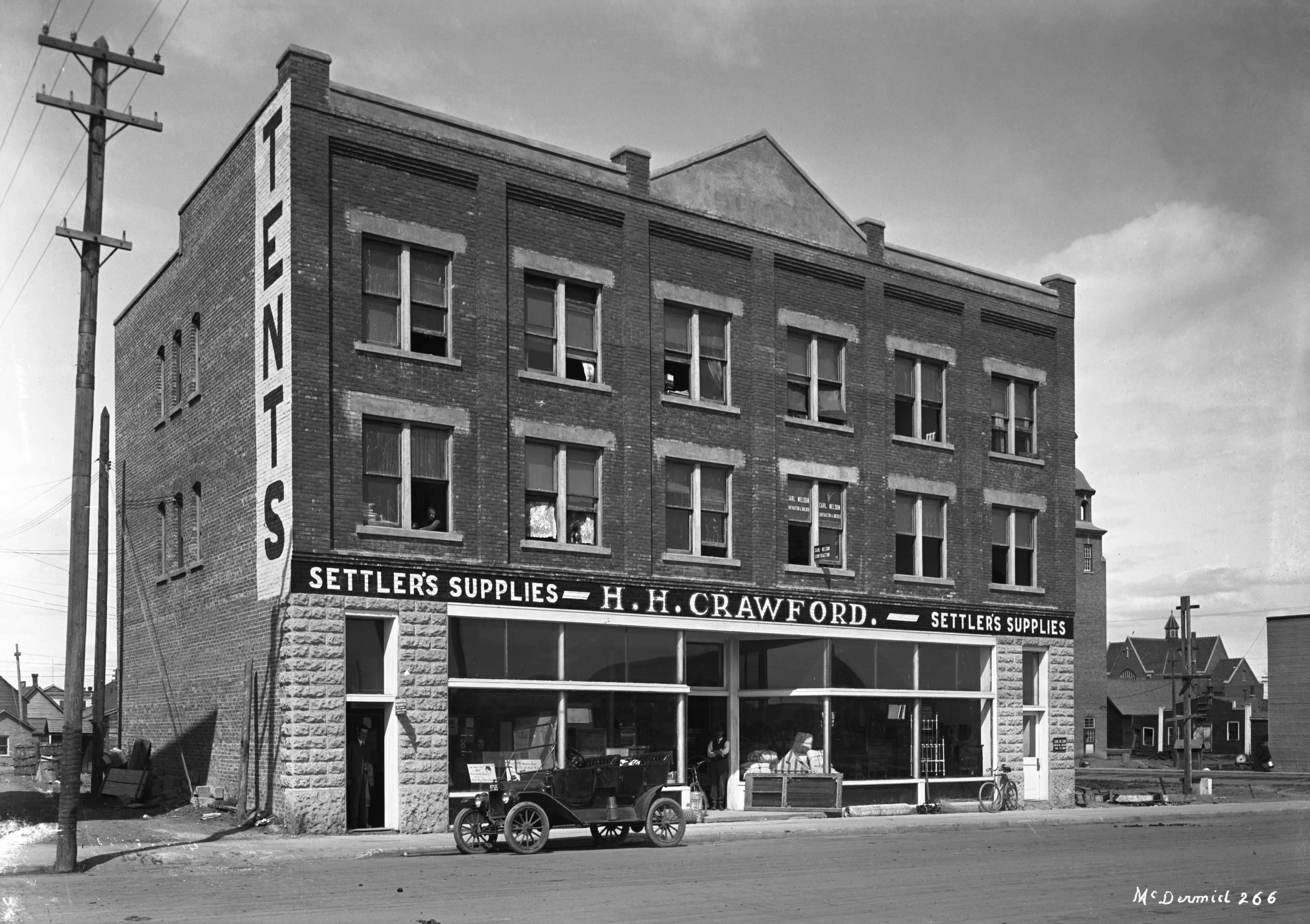Over its 102 years, the main floor of the building has served as a tent and awning store and was the longtime home of Strathcona Furniture. Nathan Siegel opened the business in 1935 and he and his family ran it for the next 61 years. It closed in June 1996 and Nathan’s son Leo sold it to Dave and Jeong-Ae Lalonde.
But first, back to the beginning, and about the guy who built it. Herbert Crawford was born in Brampton, Ontario in 1878 and headed west in 1898 or 1900 (accounts differ). He married Emily Crow in 1906, and the couple had five children – Ada, Florence, Mildred, Margaret and Beatrice.
Just like his father had, Herbert worked as an auctioneer. “He is extremely successful as an auctioneer, being at all times alert, ready for any situation or any emergency and at the same time accomplishing his purposes along the line of business,” said a biography published in 1924 in Alberta, past and present.
Crawford also began making and selling tents and awnings, and needed a manufacturing and retail space. When the chance came to buy a chunk of land on 103rd Street north of Whyte Avenue, he snapped it up.
He commenced designing his building in 1911 and chose a simple Edwardian commercial style, which was very popular at the time. A report from the city heritage planner says that the influences of the style are easy to see in the Crawford Block’s form, scale and massing.
Significant design elements include the 12 paired assembly windows on the six-bay east facade, seven pilasters above the first storey, large retail level wood-framed windows, central recessed entry, and a central triangular pediment at the parapet level. Interesting details include precast concrete lintels and sills, brick corbelling below the parapet, and coarse textured cast stone blocks on the first storey at the side of the retail frontage.
Crawford opened his auctioneer office at 8222 with his tent and awning business right next door at 8226. “Herbert H. Crawford, auctioneer and valuator, house furnishings, settler’s outfitters,” said an entry in the 1917 Henderson’s Directory. “Manufacturers of tents, awnings, wagon covers, horse blankets, mattresses, etc. 8226 103rd Street, Phone 3062.”
He was also successful in politics and ran in the 1913 provincial election in the new Edmonton South riding against former Premier Alexander Cameron Rutherford. Crawford defeated Rutherford by a large margin that was not expected and went on to be re-elected to the seat in 1917. The Edmonton South seat vanished under redistribution and Crawford was defeated in the 1921 general election.
He returned to business ventures and moved his tent-making business to 10166 Whyte Avenue. The main level of the block was taken over by Freads Chocolate for a time. By the end of the 1920s, it was home to the office of the Farmers’ Supply Co-operative.
Then Nathan Siegel and his Strathcona Furniture came along in 1935 and a local institution was born. For three generations, the Siegels provided home furnishings to Edmontonians who wanted quality at an affordable price. When Strathcona Furniture closed in June 1996 and the Lalondes bought it from the Siegel family, time and heavy use had taken a toll.
They invested some extensive work into the building and turned the main floor into Artifacts Trading Company, their gift emporium. Suites on the upper two floors were renovated to meet fire and safety codes.
Their renovation process provided its share of surprises – like original ornate tin ceilings, glorious front windows and early 20th century brick hidden under 1960s panelling. When awnings came off the building, original hand-painted signs were revealed. The Lalondes installed a new tin ceiling, using panels from a Chinatown block owned by their friend John Mah.
To get to the original subfloor, tradespeople ripped up carpet, three layers of linoleum and ¾- inch plywood. A week was spent shoring up beams and the roof, and several more days ripping out the old heating system and installing a new one.
In the basement, the original boiler, constructed by Leonard & Sons of London, Ontario, was shut off for the last time after 84 years of service and then removed piece by piece. Originally it was powered by coal and converted to natural gas, likely in the late 1920s.
Two additions were constructed at the back about 1953 and were used as furniture display areas. Eagle-eyed observers may be able to spot where the bricks have been repointed, especially above the second floor windows to the top of the parapet. The additions are to be demolished as part of the new development.
In recognition of its historical and architectural significance, the building is being declared a Municipal Historic Resource. The designation provides $166,762 to help pay the anticipated $417,000 cost of restoring the Crawford Block. Work includes refurbishment of the roof, repair and replacement of the bricks, refurbishment of the commercial frontage and replacement of the windows on the upper storeys of the east facade.
© Lawrence Herzog 2014, All Rights Reserved
Top photo:
H.H. Crawford Building, 1912. Glenbow Archives, NC-6-266.

